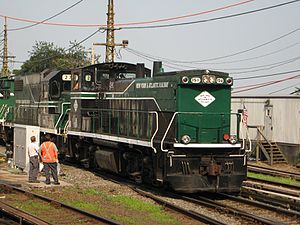The number referenced in the title is the total amount of solid waste produced per day on Long Island. And with the Brookhaven Landfill’s impending closure, combined with the State of New York’s utter abdication of regional assistance, it is up to municipal governments and the private sector to handle what will become of our waste. It is not an enviable position to be in, but it is the current state of affairs.
Currently, there is a solution proposed in the Town of Smithtown to handle the ash and construction debris disposal of the Townships of Huntington and Smithtown – the townships that utilize the services of the Huntington Covanta plant to handle their solid waste incineration.
The proposal is to utilize rails instead of trucks to dispose of the waste, which will be sent to an appropriate processing facility in Pennsylvania.
While the facility proposed by CarlsonCorp, Inc. doing business as Townline Terminal LLC, is still undergoing approval by the United States Surface Transportation Board and then the Town of Smithtown, it is an idea worthy of your consideration.
The facility would be due east of the Covanta incinerator, directly across Townline Road on the south side of the Port Jefferson Line of the LIRR. The facility will have five tracks totaling 8,600 feet and a 5,000-foot rail spur connecting it to the LIRR. It is also proposed that the site will have an 80,000-square-foot indoor facility to facilitate the transfer of the ash inside a 20,000-square-foot warehouse.
CarlsonCorp intends to modify its existing NYS DEC permit to include the two additional waste streams consisting of Non-Hazardous Municipal Solid Waste Combined Incinerator Ash (“incinerator ash”) and Non-Hazardous Construction and Demolition Debris (“C&D”). This proposed action with the NYS DEC will not include a request to increase the permitted capacity of the facility.
The combination of all waste streams will not exceed more than 365,000 tons per year. However, the quantities of each accepted waste stream may fluctuate from year to year, as the waste industry as a whole goes through ebbs and flows.
To accommodate the acceptance of these new waste streams and for the construction of the Townline Rail, the existing CarlsonCorp outdoor recycling operations will be reduced from occupying approximately 66 acres to approximately 25 acres. With that reduction in outdoor operation size, the quantities of organic materials, construction aggregates and soils stored onsite will decrease accordingly.
According to the Town of Smithtown, the plan calls for vegetative berms and buffers and the latest available technologies to reduce any impacts to the surrounding communities. The operations will be 25’ lower than all neighboring residences.
This may result in a nominal change for those that immediately border the facility. But the net result will be a reduction of trucks traversing the area, as not only will trucks carrying ash only have to travel a short distance across the street, but materials already used in the Kings Park Industrial Corridor can now be brought in via rail, as opposed to the trucks already utilized.
Yes, already utilized.
In total, 11,100 truckloads of material will either be eliminated or see their routes significantly shortened, decreasing the noise and wear and tear on our roads.
The rail facility will only see one train a day, five days per week and will not interfere with LIRR service. The train will be approximately 27 cars long, and there will be no train idling at night waiting for cars. The assemblage of train cars and the transferring of ash and construction debris will occur during daytime hours to minimize noise.
Those opposed to this plan will have you believe it is the prelude to a regional facility handling the garbage well beyond Smithtown and Huntington. However, the design of the facility and the fact that the Covanta Huntington plant is already operating at capacity tell another story.
In literature opposed to the facility, opponents will use language like “the train track with a capacity to hold 161 freight trains,” always referencing the capacity at large. However, the functioning capacity is 79 cars, as much of the track space must remain empty for excess in the possibility of a service outage and to facilitate the assemblage of the freight trains themselves. Therefore, the figure continually thrown around and then repackaged by activists is not relevant to the discussion. It is akin to saying that Harvard Avenue has the capacity to hold, say, 400 automobiles.
The fact of the matter remains that without this proposal, residents across Smithtown will see their garbage bills skyrocket, making Smithtown an even more difficult place to live for the working people that call it home.
While we are still awaiting the results of the environmental assessment, expected as early as March to make our determination as an editorial board on this project, it would appear to be the most practical solution to date.
As a town, Smithtown ought to be capable of taking out its own garbage. The opposition would be wise to avail themselves of the resources provided by the Town of Smithtown and by the proprietor of the project, who is more than willing to answer questions related to the project.







